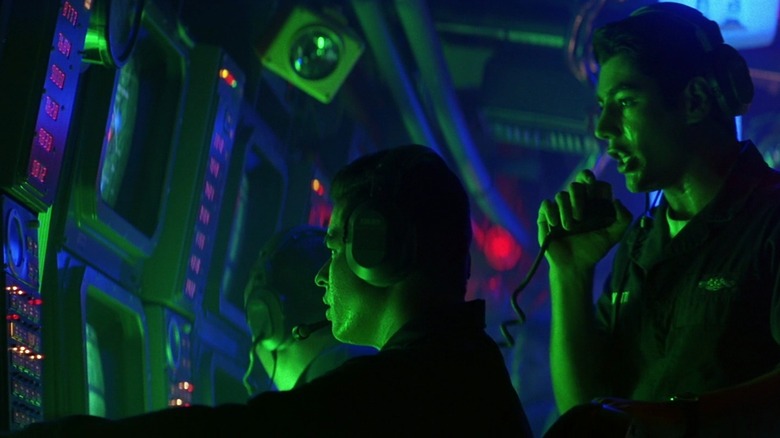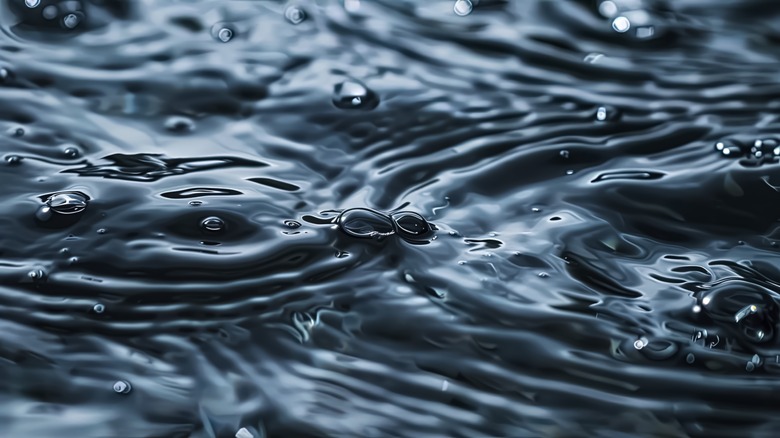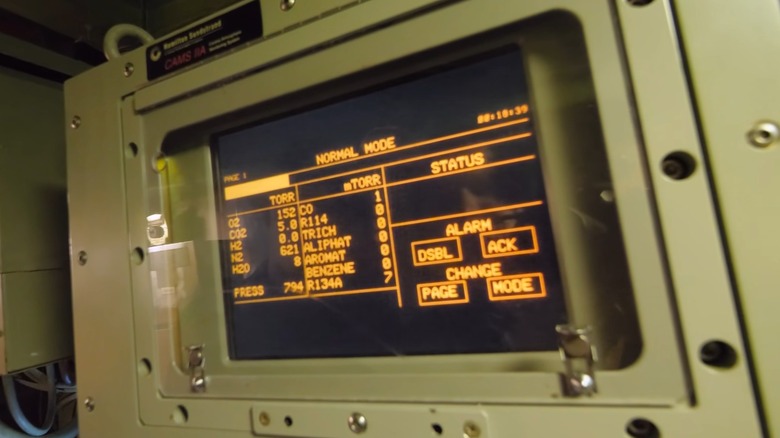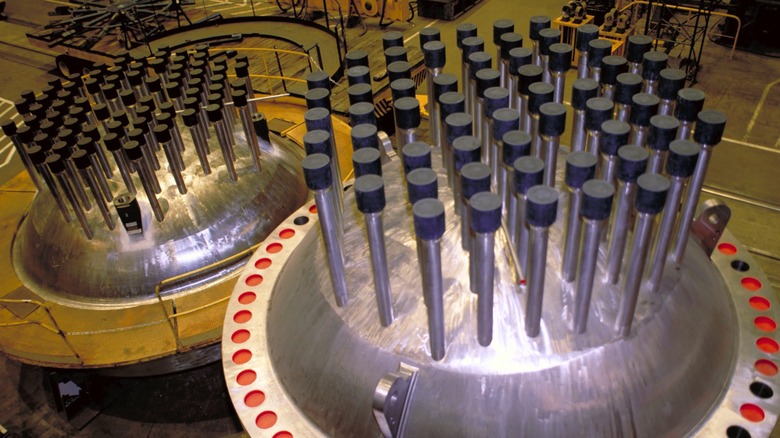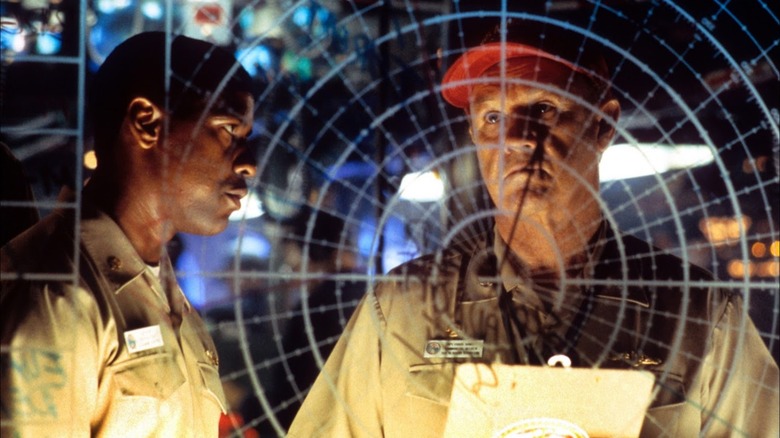What Tech Keeps Military Submarines In Service & What Do The Crews Do All Day?
Nuclear submarines make up the entirety of the United States Navy's surprisingly large submarine fleet. The U.S. operates several classes of submarines, each of which provides different capabilities depending on mission requirements. While most people think of a nuclear submarine's armament when thinking of the impressive boats, there's far more going on under the surface than most people realize, and much of the technology at work is all about sustaining the crew.
After all, a nuclear submarine can remain submerged for a long time, and the limit is only the amount of food available to the crew. The boat's fuel and water aren't a concern, and the reason for that has to do with all of the gear packed inside a submarine. Imagine being cramped inside a metal tube settled beneath the waves for a month or longer, and then throwing in as many as 130+ people, and living aboard a nuclear submarine can be challenging.
The crew manages it due to their intense training and availability of potable water, fresh oxygen, and power. There are certainly limitations that keep nuclear submarines from remaining at sea for too long, but with a resupply of food and other necessary sundries; they don't have to come in for refueling for decades. Fortunately, they don't operate that way, but they technically could. These are some of the core systems that keep the crew alive, how they work, and what the folks aboard do to make it through the day.
Freshwater generation
Freshwater is one of the most important substances for modern submarine operation, but subs operate in saltwater, which is somewhat problematic. Submarines are compact vessels, and they lack the storage capacity to carry enough freshwater to sustain the crew and keep things running. As you know, humans can't drink saltwater, so the way submariners get water for drinking is through a desalination process called distillation and reverse osmosis (RO) filtration, both of which are also important for oxygen generation.
Water distillation is the process of taking seawater and heating it into a vapor in specialized equipment. The vapor is collected as freshwater, leaving behind salt and other contaminants. Additionally, the onboard Seawater Desalination Reverse Osmosis Water Purification Unit (ROWPU) uses RO and filtration to remove salt and heavy minerals. These processes provide potable water for the crew, and some subs can generate between 10,00 and 40,000 gallons of freshwater each day. Water is used for more than just keeping the crew alive, as it's also necessary for cooling all kinds of equipment, such as computers, various electronics, and rehydrating batteries.
There's also the need for submariners to clean themselves, so water is vital aboard a submarine. In terms of oxygen generation, which we'll get into shortly, the process requires freshwater. If seawater is used, the process of electrolysis will result in the creation of chlorine gas, and nobody wants that in a submarine, so seawater must first be distilled into freshwater for this purpose. Freshwater is as much a fuel as the submarine's actual fuel because, without it, there's no way a modern sub could operate for more than a few days at sea.
Oxygen generation
In the early days of submarine technology, oxygen was supplied via hoses to the surface, but no longer. These days, technology provides what the sailors need, and it does so via oxygen generation systems. A submarine is pressurized, and it must be filled with a breathable air density of 1.2 kg/m3. A single person inhales around 2,000 gallons of O2 each day, so subs need a lot, and it's all monitored via the Central Atmosphere Monitoring System (CAMS).
There are several ways to create oxygen for a sub, but modern techniques typically involve chemical oxygen concentration. These so-called "oxygen candles" work by taking iron (Fe) and sodium chlorate (NaClO3) and igniting them at high temperatures. The result is a breakdown of the chemical components, including a release of oxygen. Electrolysis of freshwater is also used to break down water molecules into usable oxygen, which is a reliable system. There are newer and more efficient means of oxygen generation, including solid polymer oxygen generation.
These systems are faster and more efficient in generating oxygen on submarines, amounting to an increase of 50% in one-twentieth the amount of time. While oxygen generation is key, humans and machinery produce carbon dioxide, which isn't something you want to inhale. To handle CO2 buildup, which is deadly at 4% atmospheric concentration, requires scrubbers. This is accomplished via a variety of means, but the end result is a submarine filled with breathable O2 and a non-toxic concentration of C02, ensuring everyone aboard can breathe.
Energy generation
Nuclear submarines are obviously nuclear-powered, but how does it work on such a small warship? After all, ground-based nuclear power plants are massive, but they produce far more energy than is required on a submarine, so there's no reason to go that large. Also, the power generation system aboard a nuclear submarine is different in a number of ways. For starters, the generated nuclear energy only directly powers the ship. Additionally, it powers a large bank of batteries, which are used to power the ship's onboard systems.
Nuclear energy output keeps the batteries energized and regenerates energy as it is depleted. Like terrestrial power plants, a sub's nuclear reactor produces heat, which is used to generate and drive a steam turbine. This is connected to the ship's propellers, providing a near-limitless amount of energy for propulsion. One key difference, other than size, is that submarine nuclear power plants use highly enriched uranium (HRE), as it delivers more energy for the smaller reactors, which are also quieter.
The benefits of older diesel-powered submarine engines are clear, as there is no need for oxygen for combustion, and nuclear fuel lasts for years, while diesel must be continuously supplied. The energy supplied by the fission of uranium fuel powers every ship system, including the water and oxygen generators, so it's all tied together. Each system must operate for the boat to remain at sea, and if any goes down for an extended period, the submarine's combat effectiveness and overall operability will be impacted.
[Featured image by HSV via Wikimedia Commons | Cropped and scaled | Public Domain]
What the crew does all day
Each crewmember has a specific job to do, and much of what happens aboard a nuclear submarine is classified. That leaves the day-to-day activities submariners undertake to live on the boat, and you probably won't be surprised to learn there are compromises and concessions to be made. There is exercise equipment spread throughout the boat, so submariners keep themselves in shape with treadmills and free weights. For sleep, personnel "hot-rack," which means that they share beds (racks) and sleep in shifts, as there aren't enough for everyone.
Space is at a premium, so each submariner has a small space to store their gear. On top of that, contact with the outside world is severely limited, and communication is monitored. With their work out of the way and limited contact with the outside world, what's left is entertainment, and there are several options aboard a nuclear submarine. There are often televisions in the mess and crew areas, so the crew can watch movies and play video games. Other options include playing cards or tabletop games.
When it comes time to bathe, there's an etiquette among submariners such that showers are limited to three to five minutes. This is done for water conservation and also out of necessity, as space is limited. Ultimately, like most people serving in the military, submariners find ways to keep themselves entertained and maintain esprit de corps, which isn't as easy on a sub's six-month deployment as it is aboard a surface ship or assignments on dry land.
